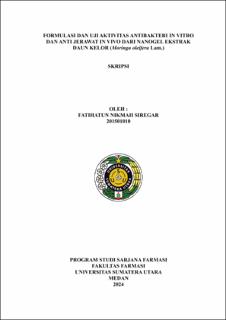| dc.description.abstract | Background: Acne can be caused by bacterial infection and excessive oil gland production. Moringa leaf extract (Moringa oleifera Lam.) contains flavonoids, tannins and steroids that can inhibit the growth of acne-causing bacteria, Propionibacterium acnes and Staphylococcus aureus. Moringa leaf extract formulated in the form of nanogels is expected to be more effective in overcoming acne because it can increase the absorption of active substances in the skin.
Research Objective: To formulate nanogel of moringa leaf extract, evaluate its physical stability, analyze its antibacterial and anti-acne activity..
Methods: Moringa leaves were extracted by maceration method and then the thick extract was subjected to antibacterial test against Propionibacterium acnes and Staphylococcus aureus. Nanogels and gels were formulated in three variations of moringa leaf extract concentration F1 (6.5%), F2 (7.5%), and F3 (8.5%). Furthermore, physical stability was tested for 12 weeks at various temperatures, cycling tests, homogeneity, viscosity, spreadability, pH, particle size, antibacterial and anti-acne tests on volunteers and irritation tests and compared with the gel preparation and gel in the market.
Results: The results of the antibacterial activity test of moringa leaf extract at a concentration of 8.5% showed an inhibition zone diameter of 9.20 mm (semi-active 9-12 mm) against Propionibacterium acnes and 8.83 mm (inactive <9 mm) against Staphylococcus aureus. The resulting nanogel is green-brown, viscous, has a distinctive odor, homogeneous, has a particle size of 256-273 nm, has no physical changes (odor, color and consistency) and a slightly increased particle size of 414-438 nm. Nanogel F3 (8.5%) had the largest inhibition zone diameter of 12.55 ± 0.09 mm against Propionibacterium acnes and 12.37 ± 0.15 mm against Staphylococcus aureus. Nanogel F3 (8.5%) and gel F3 (8.5%) did not irritate the skin in volunteers. The highest reduction in sebum levels and number of pimples was produced by F3 (8.5%) nanogel, 44.76%±1.04% and 62.60%±3.64%, but lower than the market gel, 52.71%±0.95% and 84.59%±2.52%.
Conclusion: Moringa leaf extract can inhibit acne-causing bacteria. Moringa leaf extract nanogel F3 (8.5%) had the greatest antibacterial activity, decreased sebum levels and decreased the number of pimples of other nanogel and gel preparations. Nanogel showed an increase in activity to reduce sebum levels and the number of acne by 42.26% and 32.50% compared to the gel preparation. | en_US |


